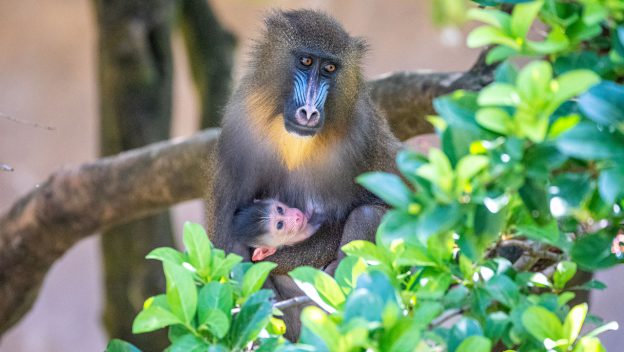Sing it with me – “It’s the circle of life … and it moves us all!”
Like the famous scene in “The Lion King,” join us in celebrating the birth of an adorable baby mandrill at Disney’s Animal Kingdom Theme Park!
Weighing less than three pounds, this pint-sized baby girl is named Saffron and could almost fit in the palm of your hand. Despite this newborn’s current size, mandrills are the largest species of monkeys in the world, and she could grow up to 25 pounds in a few years. For now, though, Saffron is clinging tightly to her mom Hazel and nursing in the treetops of their habitat on Kilimanjaro Safaris.

Moms assume most parental responsibilities in mandrill social structures, and Hazel has been sweet and nurturing since Saffron’s birth on July 24. Similar to how a human soothes a baby by rocking it back and forth, Hazel will often groom Saffron to comfort her. The bond between the two has been inseparable, and even Saffron’s sister Ivy has yet to hold her.

Like Rafiki, “The Lion King” character who was based on this species, mandrills are well known for their vibrant colors, including brilliant shades of blue, red and pink on their faces and yellow manes. Their colorations and patterns are unique, and no two strands of hair are the same. Similar to her namesake, Saffron will develop her unique and bright coloration once she fully matures in three to four years.

Mandrills are just as colorful on their back side, too, which helps the horde – or family group – follow each other as they travel through the dense forests of Africa.
With only about 4,000 mandrills remaining in the wilds of Africa, this new addition is great news for this vulnerable species. Saffron’s birth is an example of how we work with the Association of Zoos and Aquariums’ Species Survival Plan to help ensure the responsible breeding of endangered species in managed care to create healthy and genetically diverse populations of animals for years to come.

But that isn’t the only way we’re working to help this vulnerable species. Disney’s Animals, Science and Environment collaborated with Durham University and the Jane Goodall Institute to help rescued and rehabilitated mandrills return to their native habitats in Republic of the Congo.
Through the measuring of hormone levels, our science team at Disney’s Animal Kingdom were able to verify these rehabilitated mandrills were not only thriving after being re-released but also extending the size of the family troop with the addition of two new babies.
For more updates on mandrills, Hazel, Saffron and all the animals in our care, follow our amazing team on Facebook and Instagram!



